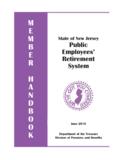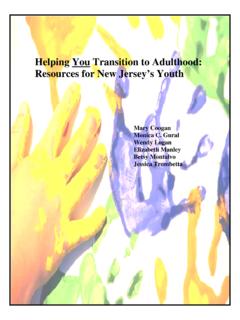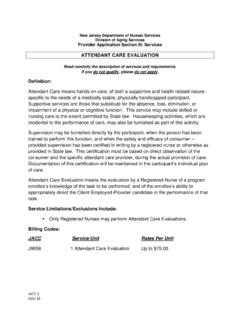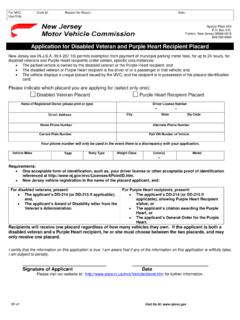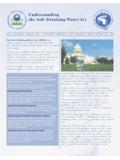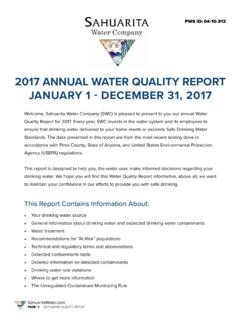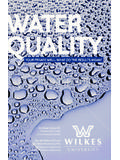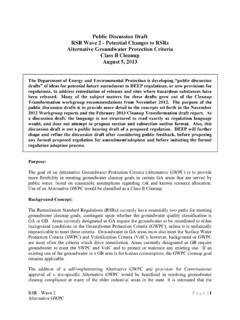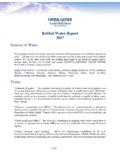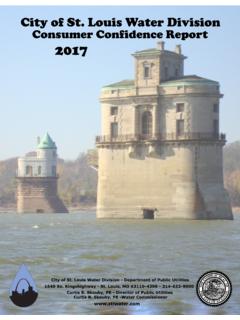Transcription of PRIVATE WELL TESTING ACT PROGRAM - New Jersey
1 NEW Jersey DEPARTMENT OF ENVIRONMENTAL PROTECTION well TEST RESULTS FOR SEPTEMBER 2002 APRIL 2007 New Jersey PRIVATE well TESTING Act PROGRAM September 2002 April 2007 PPRRIIVVAATTEE WWEELLLL TTEESSTTIINNGG AACCTT PPRROOGGRRAAMM July 2008 ii Written and prepared by NJ Department of Environmental Protection Division of Water Supply / Bureau of Safe Drinking Water And Division of Science, Research and Technology July 2008 iiiTable of Contents EXECUTIVE V BENEFITS OF THE PRIVATE well TESTING PART 1: INTRODUCTION ..1 SUMMARY OF THE NEW Jersey PRIVATE well TESTING WHO IS REQUIRED TO TEST AND WHEN? ..3 WHO DOES THE TESTING AND WHAT ARE ACCEPTABLE TEST RESULTS? ..3 HOW DOES THE DATA GET SUBMITTED TO THE NJDEP? ..4 WHAT IF CONTAMINANTS ARE FOUND?..5 LIMITATIONS OF THE PART 2: PRIVATE well TESTING ACT TEST RESULTS ..7 DATA FROM THE PRIVATE well TESTING ACT PRIMARY 1.
2 Bacteriological: Fecal Coliform or Escherichia coli (E. coli)..9 2. Inorganic chemicals ..12 A. B. C. D. 3. Gross Alpha Particle 4. Volatile Organic SECONDARY WHAT ARE THE DATA TELLING US ABOUT PRIVATE WELLS?..25 LEAD TESTING RESULTS (VARIABILITY IN RESULTS) ..28 PART 3: PRIVATE well TESTING ACT EDUCATION AND COMMUNICATION EDUCATIONAL AND OUTREACH PART 4: CASE STUDIES ..33 PRIVATE well TESTING ACT CASE STUDY #1 - EVESHAM TOWNSHIP, BURLINGTON PRIVATE well TESTING ACT CASE STUDY #2 - BYRAM TOWNSHIP, SUSSEX Tables Table E1: List of PRIVATE well TESTING Act PROGRAM Analytes .. vii Table 1: List of PRIVATE well TESTING Act 2 Table 2: Regulated Volatile Organics Compounds, MCLs and Sources .. 22 Table 3: Summary of Volatile Organic Compounds Results .. 23 iv Figures Figure E: Wells Sampled and Submitted Data to the PWTA PROGRAM .. vi Figure E1: Statewide Summary of PRIVATE well TESTING Act Results For Primary Drinking Water ix Figure E2: Percent of Wells with Results that Exceeded the Recommended Upper Limit for Secondary Parameters.
3 X Figure 1: Number of Wells Sampled by County .. 7 Figure 2: Wells Sampled and Submitted Data to the PWTA PROGRAM .. 8 Figure 3: Positive E. Coli/Fecal Coliform Exceedances Reported to the PWTA PROGRAM .. 10 Figure 5: Arsenic Exceedances Reported to the PWTA PROGRAM .. 15 Figure 6: Mercury Exceedances Reported to the PWTA PROGRAM .. 17 Figure 7: Gross Alpha Exceedances Reported to the PWTA 20 Figure 8: VOCs Primary Standards Exceedances Reported to the PWTA PROGRAM .. 21 Figure 9: Percent of Wells with Results that Exceeded the Recommended Upper Limit for Secondary Parameters .. 25 Figure 10: Statewide Summary of PWTA Results For Primary Drinking Water 27 Figure 11: Southern New Jersey - Summary of PRIVATE well TESTING Act Results for Primary Drinking Water 27 Figure 12: Northern New Jersey - Summary of PRIVATE well TESTING Act Results For Primary Drinking Water 28 Figure 13: Lead in Water Samples.
4 30 Appendices Appendix A: Definitions and Terms .. 35 Appendix B: PRIVATE well TESTING Act Analytes and Applicable 39 Appendix C: PRIVATE well TESTING Act Required Parameters by County .. 41 Appendix D: New Jersey PRIVATE well Test Reporting Form .. 43 Appendix E: PRIVATE well TESTING Act Results by County for Fecal from September 2002 to April Appendix F: PRIVATE well TESTING Act Results by County for Nitrates from September 2002 to April 2007 .. 55 Appendix G: PRIVATE well TESTING Act Results by County for Arsenic from September 2002 to April 2007 .. 57 Appendix H: PRIVATE well TESTING Act Results by County for Mercury from September 2002 to April 2007 .. 59 Appendix I: PRIVATE well TESTING Act Results by County for Gross Alpha from September 2002 to April 2007 .. 61 Appendix J: PRIVATE well TESTING Act Results by County for VOCs from September 2002 to April 63 vExecutive Summary The goal of the PRIVATE well TESTING Act (PWTA or Act) is to ensure that purchasers and lessees of properties served by PRIVATE potable wells are fully aware of the quality of the drinking water source prior to sale or lease of a home or business.
5 The New Jersey PRIVATE well TESTING Act, as set forth at 58:12A-26 et seq., was signed into law in March of 2001 and became effective in September 2002. State lawmakers were prompted to pass the PWTA because of PRIVATE well contamination discovered throughout the State. To address this concern, the PWTA requires the buyer or the seller of real property to test the well water prior to sale and review the results prior to closing of title. It also requires landlords to test the PRIVATE well water supplied to their tenants and provide their tenants with a written copy of the results. The data generated by this PROGRAM are provided to the homeowners by the laboratory performing the analyses and then sent to the New Jersey Department of Environmental Protection (NJDEP), Bureau of Safe Drinking Water. The NJDEP notifies local health agencies when a well within their jurisdiction is tested under the PWTA.
6 The data from the PWTA are used by NJDEP to assess the quality of the water from PRIVATE wells throughout the state. The information in this report meets the confidentiality requirements of the Act; the Act allows the release of PWTA information as a compilation of water test results by state, region and county and municipality. The names of specific property owners, their addresses or locations are not included. The report is also required to be made available free of charge to the public. Summary of well Test Results for September 2002 April 2007 This is the second report summarizing the results from the PRIVATE well TESTING Act. It follows the release of the initial PWTA report in March 2004, entitled Initial well Test Results for September 2002 March 2003. This report provides a summary of the water test results submitted to the NJDEP in the first four and half years of the PWTA PROGRAM , over the period of September 2002 to April 2007, and confirms many of the findings identified in the initial report.
7 A total of 55,749 well water samples were analyzed from 51,028 separate wells during the period of September 2002 to April 2007. The samples results are biased using the highest test result value when more than one sample was collected at the same property. The 51,028 wells sampled represents about 13% of the estimated 400,000 PRIVATE wells used for drinking water in New Jersey . viFigure E1: Wells Sampled and Submitted Data to the PWTA PROGRAM viiAs required by law, the PWTA test results represent untreated (raw) water quality. The samples for the PWTA are collected prior to any water treatment system. In some cases, treatment systems may already be in place to remove or lessen the degree of contamination. The NJDEP s new database accepts information regarding on site treatment, if applicable. If the homeowner treats the water, the PWTA test results do not reflect the drinking water quality that is being consumed after the water passes through the treatment system.
8 When water sample results exceed drinking water standards, local health departments are notified and further post-treatment samples collected at a kitchen tap are recommended to determine the quality of the water consumed and to evaluate the effectiveness of any treatment system. Results of these follow-up samples taken by the buyer or the seller of a property are not required to be sent to NJDEP. Contaminants Included in the PRIVATE well TESTING Act The PWTA requires that all wells covered by the Act be tested for the presence of 29 primary drinking water contaminants:1 bacteria, nitrate, lead, and 26 volatile organic chemicals. Certain areas of the state are also required to test for three additional primary drinking water contaminants: arsenic, mercury and gross alpha particle activity. TESTING for three secondary parameters (pH, iron and manganese) is also required.
9 See Table E1 for the list of PWTA parameters. Table E1: List of PRIVATE well TESTING Act PROGRAM Analytes PPrriimmaarryy CCoonnttaammiinnaannttss Secondary Parameters Bacteriological: Total Coliform (Fecal or E. coli) With Optimum Range: pH Organics: All 26 Volatile Organic Compounds with Maximum Contaminant Levels With Recommended Upper Limits: Iron Manganese Inorganics: Arsenic* Lead Mercury* Nitrates Radiological: 48-Hour Rapid Gross Alpha Particle Activity* *These parameters are required only in certain counties The test results from the PWTA sampling are compared to the Maximum Contaminant Levels that have been established by the Federal and State drinking water regulations. 1 A primary drinking water standard protects public health by limiting the levels of contaminants in drinking water. viiiA Maximum Contaminant Level (MCL) is the highest level of a contaminant that is allowed in drinking water.
10 Two of the 29 primary contaminants are handled somewhat differently in this report. The first exception is lead, which has an Action Level of 15 ug/L. An Action Level is different than an MCL. Since the majority of lead in drinking water is attributed to leaching from the pipes and distribution system, the action required by the Safe Drinking Water regulations centers on corrosion control and public notice. Since the PWTA PROGRAM requires TESTING of untreated water, the State's Ground Water Quality Standard (GWQS) is used as a surrogate in the absence of an MCL established under the Safe Drinking Water Act. An exceedance for lead under the PWTA is thus determined by comparing the well test results to the GWQS. The GWQS for lead was lowered from 10 micrograms per liter ( g/l) to 5 g/l on November 7, 2005. The second exception is arsenic.

